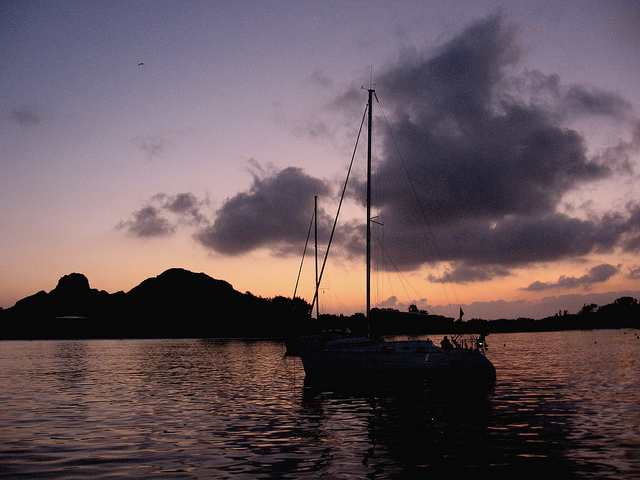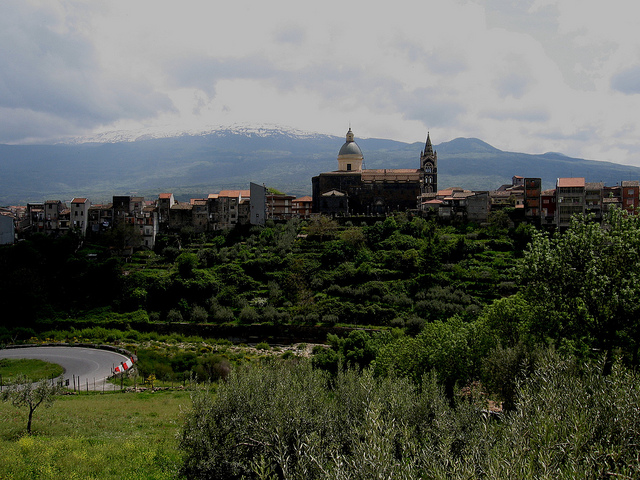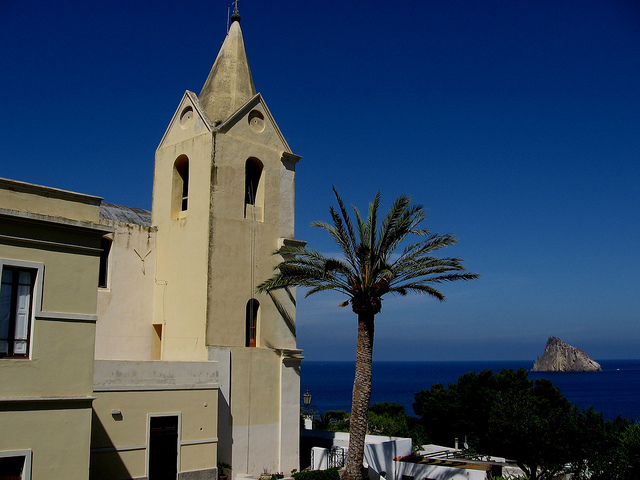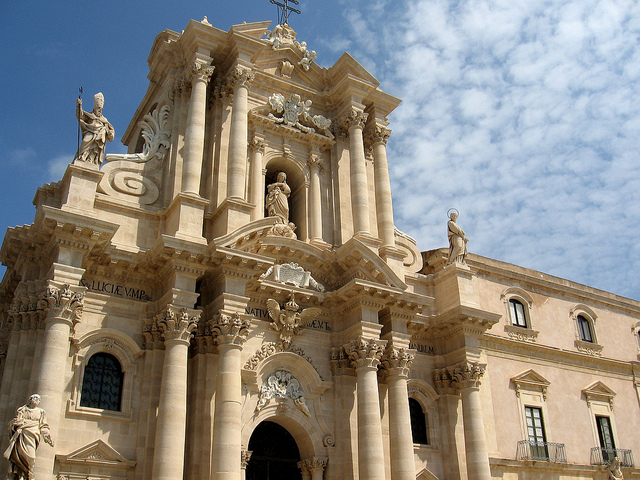Our beautiful dinner in the old town of Lipari last night was another opportunity to get to know Sicilian cuisine. A light-hearted evening was followed by a night of deep sleep and by 8 am this morning I stuck my head out of the boat: another gorgeous day! Everyone was still sleeping and I had about an hour and half to walk into town and catch another glimpse of picturesque Lipari. I mailed my postcards and picked up some fresh locally grown oranges for the gang on the boat.

View of the bay north of Lipari from the Castello
Once back at the boat, my co-travellers Herbert, Claudia and I were ready for another excursion: a driving tour of Lipari. Herbert is a German TV travel journalist and is planning to bring a television crew to Sicily next year to film the Italian language learning experience aboard a sailboat provided by Laboratorio Linguistico. Naturally he has to scout out the various locations to check into sights of interest, lighting, and facilities – all the factors that will have a bearing on the shoot.

View of the Bay of Canneto
He had asked our captain Francesco to arrange for a local guide who would drive him around the island and generously invited Claudia and me to come along. Our driver Pasquale Liberatore (what a great name), a Lipari resident, arrived punctually at 9:30 am to pick us up at the Lipari pleasure craft harbour to take us on a tour through this beautiful island.

View of Lipari from the South
Pasquale packed us into his vehicle and off we went. His personal story, incidentally, is also quite interesting: Pasquale was born and grew up in Lipari and then in the lat 1950s his family emigrated to Melbourne, Australia, where there is a large community of southern Italian émigrés. Southern Italy went through real economic hardship after World War II, and many hundreds of thousands of people emigrated from the mainland and the islands. Pasquale spent a few decades in Australia but as the only person from his immediate family, he returned to Lipari to live here. He has now been back for about 15 years and loves living here although he occasionally misses his brothers and sisters and their families who are still living in Australia. Of course he speaks excellent English, and that is how he markets himself – Pasquale, the English-speaking cab driver and tour guide.

Pasquale, our cab driver, showing us some pumice stone
The first place he took us to was a village north of Lipari called Canneto which has a beautiful waterfront location, draped around a horseshoe-shaped bay. We decided to catch a little late breakfast first, and I really enjoyed my refreshing lemon granita, a typical Sicilian specialty – crushed ice that comes in a variety of flavours, a great idea for starting off the day. Herbert enjoyed a fresh croissant and an espresso.
On our way out of the bar, parked by the lungomare, the waterfront promenade, a local fisherman was selling fresh fish he caught this morning out of a little three-wheeled cargo vehicle. He shouted out the names of the fish with a peculiar cadence that was sure to attract the attention of passers-by. This is one thing I noticed about Sicily: street selling, particularly of fish, produce and other edible products, is still a popular way of marketing one’s merchandise.

Fish, anyone?
We continued our drive towards the white pumice quarries that Lipari is famous for. This volcanic stone is used for the production of cement, as an abrasive and a cosmetic exfoliant. Pumice is a highly porous, extremely light-weight, usually white stone that is formed during volcanic eruptions. Just a few dozen meters away from the pumice quarries we stopped to see another type of volcanic stone: obsidian, or volcanic glass, which is a dark-brown, dense, virtually opaque and heavy substance.

Pumice and obsidian are plentiful on the island of Lipari
Pasquale explained that the chemical make-up of obsidian and pumice is essentially the same, but that they are ejected a different temperatures during volcanic eruptions. Obsidian has been used for eons; because of its flint-like quality it can easily be shaped into blades and spear tips and other cutting instruments. Today obsidian is even used as for surgical scalpels which produce less trauma than steel scalpels. Another less high-tech use of obsidian is as a gemstone, and many stores in the Eolian Islands sell jewelry crafted from this volcanic glass.

The beautiful view of Salina from the Chiesa Vecchia di Quattropani
We came around the northern tip of Lipari where a beautiful view opened up toward the island of Salina. Pasquale took us up a mountain road to the Santuario di Chiesa Vecchia di Quattropani, a beautiful country church located on a hill with a phenomenal view over several of the Eolian Islands. As we were standing by the railing of the terrace, a jet fighter flew by at what seemed like supersonic speed, literally a few meters above the water. By the time we realized where the booming sound was coming from it was already disappearing into the horizon.

Chiesa Vecchia di Quattropani with a Fiat Cinquecento



